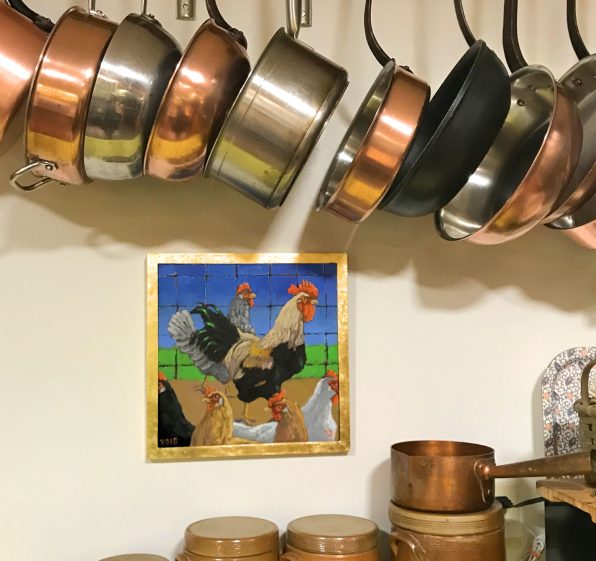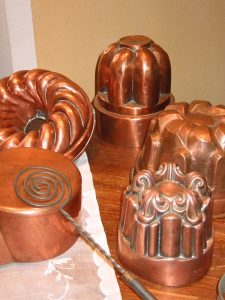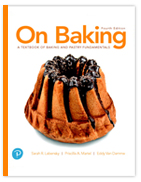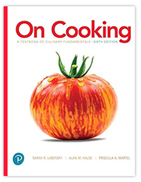Ninety percent of U.S. consumers replace their cookware every ten years, a fact I learned listening to a cookware trend seminar recently. In a household with pots and pans from the 1970’s in daily use, this shocks me. Then again, there is a trend towards better cookware. People must be trading up.
We cook in the same professional copper cookware we used professionally over 30 years ago. Some of our pans are even older; Charlie picked them up when he traveled in the 1970’s. Why? We are traditionalists of course. But also appreciative of the benefits of using copper cookware along with black steel and all stainless steel pans too.
Copper conducts heat quickly, ensuring that your pan heats up right away and maintains a steady heat. (Copper heats 25 times more quickly than stainless steel, an indication of the energy savings when cooking in copper.) Unlike a lightweight stainless steel pan, copper won’t develop hot spots. Copper pans cook evenly.
Because copper is a reactive metal, it must be lined with a nonreactive material, either a coating of tin, silver, nickel or stainless steel. We have always used stainless-steel lined copper pans made for use in professional kitchens. They are indestructible with all the benefits of copper. Tin-lined copper cookware is a dream however. A tin-lined copper sauté pan heats up in a flash and it sears food beautifully. But tin wears off and requires maintenance by a professional tinsmith.
If you’re looking to build a collection of copper cookware, you might get lucky and find good quality tin-lined copper pots at yard sales or online. Or consider purchasing it from a manufacturer such as Matfer Bourgeat. Weight is a good indicator of quality. (Weight is also a drawback. Lifting a 14-inch sautoir of simmering stew is equivalent of an upper body workout.) You want to see a pan thickness of 2.5 to 3 millimeters. Also look for cookware with cast iron or steel handles. These metals don’t get hot as quickly as brass, which appear on pans used for table side service where appearance matters.
We recommend East Coast Tinning for resurfacing tin-lined copper. They also hand-forge lust worthy copper pots under the brand Duparquet.
Maintaining Professional Copper Cookware
Did you find a cool piece of copper cookware at a yard sale? Did someone bequeath you a couple of banged-up copper jelly molds? Or are you collectors like us? There is no getting around the fact that copper like these pieces from the Escoffier Museum of Culinary Art must be polished.
After each use, clean and polish your copper. This makes keeping the copper from tarnishing so much easier. Never place copper cookware in the dishwasher. And take great care of the tin-lining, which should never be scrubbed with a souring pad or cleanser.
Mild acids such as salt and vinegar alter the color of copper. They can be used to restore copper’s bright color. But polish is needed to add luster and keep the pots from tarnishing.
Here is what we do.
- Clean the pot to remove all food stains.
- Run hot water over the outside of the pot.
- Dip a sponge in a solution salt and vinegar. Rub the copper and watch it brighten. (Or use a product like Bar Keeper’s Friend, which is excellent if rough on household plumbing.)
- Rinse with cool water and dry thoroughly.
For a lasting glow, there is one extra step we recommend. It is what we do for display pieces and those we don’t use often. (Fish poacher anyone?) After polishing, rinsing and drying the copper, apply a fine metal polish. We like Wenol Metal Polish
Apply the Wenol or other metal polish to a soft cloth. Wear gloves and take care with this product, which is toxic. Squeeze a tiny amount onto a soft disposable cloth. Work on small sections at a time rubbing in a circular motion. As soon as your cloth turns black, which it will, use a clean section of the cloth.
Your copper will stay shiny for several months. And even then, it will darken into a dusky bronze, an attractive effect.







